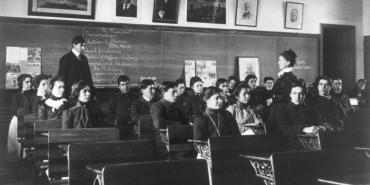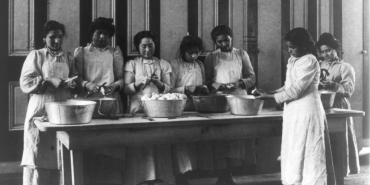The horrific treatment of Native peoples is a stain on our nation’s history—and on our present and future. The legacy of oppression, combined with current widespread lack of knowledge about Native peoples, contributes to vast inequities today. Fortunately, where ignorance is core to this problem, excellent teaching is essential to its remedy. Here, I answer four key questions about the education of Native students and the challenges that remain.
How Has Federal Indian Education Policy Been Shaped?
Throughout the history of the United States, a number of different eras have defined the federal government’s policies toward American Indian peoples, which in turn has shaped the ways in which the federal government approaches Indian education. From the late 1700s until the early 1800s, the federal government established treaties with Indian tribes. In most of these treaties, tribes ceded land to the federal government in exchange for the provision of health, education, and welfare for American Indian peoples. Unfortunately, the federal government has repeatedly failed to honor the provisions outlined in many of these treaties, including the provision of educational supports and services. A prime example of this is evidenced in the operation of off-reservation boarding schools during the 1800s.
Although many of these schools were rightly characterized by some as “oppressive, harshly abusive, and rigid,”1 it has also been argued2 that Colonel Richard Henry Pratt, founder of one of the most well-known off-reservation boarding schools, Carlisle Indian Industrial School, viewed these institutions as a means of preventing the wide-scale killing of Native peoples at the hands of the US government and its military forces. Regardless of the intent of boarding schools, there is evidence to suggest that such an approach not only resulted in forced acculturation and assimilation of many Native children but also resulted in the physical separation of Native children from their families and, in many cases, death.
Unfortunately, it was not until the 1960s that tribes began to reclaim some degree of control over the education of Native children and youth.
In 1969, the US Senate issued a report titled Indian Education: A National Tragedy—A National Challenge (also known as the Kennedy Report).3 Citing the failure of public schools, as well as schools operated by the Bureau of Indian Affairs, to adequately educate American Indian children, this report found high dropout rates, academic achievement significantly lagging behind that of white students, a lack of American Indian teachers and principals, and a low sense of academic ability among some Native children.
Such problems were documented long before the Senate’s report. Dating back to the federally commissioned Meriam Report of 1928, there were calls to immediately address a number of concerns across Indian country. The Meriam Report found that, “The most fundamental need in Indian education is a change in point of view. Whatever may have been the official government attitude, education for the Indian in the past has proceeded largely on the theory that it is necessary to remove the Indian child as far as possible from his home environment.”4 This report went on to argue that, “The Indian educational program cannot simply take over the traditional type of school; it must set up its own objectives, finding out in general and for each reservation or tribal group the things that need to be done. It cannot too positively be stated that mere schooling, of the unrelated academic type, is not the educational answer to the Indian problem.”5
Findings of the Meriam Report were echoed in a 1974 report by the National Advisory Council on Indian Education, which argued, “There are no quick and easy solutions in this tragic state of affairs; but clearly, effective education lies at the heart of any lasting solution.”6 This council went on to argue “that education should no longer be one which assumes that cultural differences mean cultural inferiority.”7
To redress “this tragic state of affairs,” federal laws were passed in the 1970s that provided guidance on the education of Native children and that called for increased tribal control, including oversight and direction of Indian education.8 In spite of the passage of such landmark legislation, the federal government and its agents failed to meet the federal trust responsibility for the education of Native children. In 1991, the Indian Nations at Risk report9 cited the (1) failure of public schools to educate many Native children, (2) loss of Indigenous languages and cultures, (3) attacks on Native lands, and (4) failure to appropriately acknowledge and support tribes’ right to exist as fully self-determined individuals and groups.
Who Are American Indian Children and Youth Today?
There are approximately 640,000 American Indian and Alaska Native students living in all 50 states, with more than 100,000 residing in the state of Oklahoma alone. Many live in geographically isolated areas, making it difficult to access needed educational supports and services.10 Providing these supports and services to Native students is complicated not only by geographic isolation and dispersion, but by the wide array of tribal, cultural, and linguistic diversity represented among this nation’s Native peoples. This is evidenced by the fact that there are more than 600 state and federally recognized tribes, with approximately 170 different Indigenous languages, in addition to English, spoken.11
Where Are Native Students Educated Today?
The majority of Native children (approximately 90 percent) attend public schools. The remainder attend schools operated or funded by the Bureau of Indian Education (BIE), located within the Bureau of Indian Affairs in the US Department of the Interior, or private schools.12 There are approximately 180 schools, including boarding schools, operated or funded by the BIE and tribes.* Of these, approximately 130 schools are contracted out to tribes to support the enactment of “tribal self-determination,”13 which is a move toward increased tribal self-government (including the right to determine and control the priorities and future directions of tribal nations and their citizens). Similar to public schools and school districts, curriculum and instruction—and the extent to which Native languages, cultures, and histories are taught—varies from one tribally operated school to the next. Although the BIE is tasked with fiscal oversight of many of these schools, a recent report by the US Government Accountability Office14 found problems with financial management, facilities, and staffing. The lack of adequate financial management often causes delays in the hiring of teachers and other personnel, resulting in students not receiving timely or adequate educational supports or services. Similarly, the lack of fiscal resources and oversight results in many school buildings that are in need of repair.
How Can We Ensure Native Children Have Access to Culturally Relevant Teaching and Learning Practices in Schools?
Unfortunately, longstanding issues persist, as evidenced by a lack of fiscal and physical resources in BIE-operated and -funded schools, tribal schools, and public schools. As a result, many Native children and youth continue to attend schools where there are few Native teachers and administrators, there is a lack of culturally responsive and relevant curricula and related instructional practices, education programs are underfunded, and facilities are inadequately resourced and maintained.15
In recent years, however, state and federal agencies have come together to identify and work to address persistent inequalities in the education of Native students. An example of this collaboration is the federally funded National Indian Education Study,16 conducted in conjunction with the National Assessment of Educational Progress. This study provides a unique opportunity for tribes, states, governmental agencies, and others to explore and better understand the ways in which Native languages and cultures are incorporated into the teaching and learning environment.† As the members of the Technical Review Panel for the National Indian Education Study point out, “One of the greatest challenges [for educators] is ensuring that Native students are able to perform well academically while maintaining their Native cultures and languages.”17 In order to meet this challenge, it is imperative that educators, parents, and community members have a sense of how Native languages, cultures, traditions, and funds of knowledge are being incorporated into the teaching and learning process within multiple types of schools. This is critical if we are to ensure that Native children have access to and benefit from culturally relevant teaching and learning practices in school.
Susan C. Faircloth, an enrolled member of the Coharie Tribe, is a professor in and the director of the School of Education at Colorado State University, where her scholarship focuses on the education of Indigenous students. She currently chairs the Technical Review Panel for the National Indian Education Study funded by the Office of Indian Education within the US Department of Education.
*For more information on BIE schools, visit bie.edu/schools. (return to article)
†For more on the importance of building on students’ cultures, see How People Learn II: Learners, Contexts, and Cultures. (return to article)
Endnotes
1. K. Lomawaima and J. Ostler, “Reconsidering Richard Henry Pratt: Cultural Genocide and Native Liberation in an Era of Racial Oppression,” Journal of American Indian Education 57, no. 1 (2018): 82.
2. See, for example, Lomawaima and Ostler, “Reconsidering Richard Henry Pratt.”
3. Indian Education: A National Tragedy—A National Challenge, 1969 Report of the Committee on Labor and Public Welfare, US Senate, Made by Its Special Subcommittee on Indian Education, Report No. 91-501 (Washington, DC: US Government Printing Office, 1969).
4. L. Meriam, The Problem of Indian Administration: Report of a Survey Made at the Request of Honorable Hubert Work, Secretary of the Interior, and Submitted to Him (Washington, DC: Brookings Institution, 1928), 346.
5. Meriam, The Problem of Indian Administration, 349.
6. National Advisory Council on Indian Education, First Annual Report to the Congress of the United States from the National Advisory Council on Indian Education (Washington, DC: US Government Printing Office, 1974), 92.
7. National Advisory Council on Indian Education, First Annual Report, 92.
8. For additional information on landmark legislation, see J. Tippeconnic, “A Survey: Attitudes Toward the Education of American Indians,” Journal of American Indian Education 28, no. 1 (1988).
9. Indian Nations at Risk: An Educational Strategy for Action, Final Report of the Indian Nations at Risk Task Force (Washington, DC: US Department of Education, 1991).
10. National Congress of American Indians, Tribal Nations and the United States: An Introduction (Washington, DC: 2015).
11. US Census Bureau, “Native North American Languages Spoken at Home in the United States and Puerto Rico: 2006–2010,” US Department of Commerce, December 2011, www2.census.gov/library/publications/2011/acs/acsbr10-10.pdf.
12. National Congress of American Indians, Tribal Leaders Toolkit: Education Choice for Indian Country; Supporting Tribal Decision Making for Schools and Students (Washington, DC: 2018).
13. For more on self-determination, see, for example, S. Cornell and J. Kalt, “American Indian Self-Determination: The Political Economy of a Successful Policy,” JOPNA Working Paper No. 1, Native Nations Institute for Leadership, Management, and Policy et al., 2010.
14. US Government Accountability Office, Bureau of Indian Education Needs to Improve Oversight of School Spending, GAO-15-121 (Washington, DC: November 2014).
15. National Congress of American Indians, Tribal Leaders Toolkit.
16. For results of the 2015 National Indian Education Study, see National Center for Education Statistics, National Indian Education Study 2015: American Indian and Alaska Native Students at Grades 4 and 8, NCES 2017-161 (Washington, DC: US Department of Education, 2017); and National Center for Education Statistics, National Indian Education Study 2015: A Closer Look, NCES 2019-048 (Washington, DC: US Department of Education, 2019).
17. Technical Review Panel for the National Indian Education Study, National Indian Education Study 2015: Setting the Context (Sault Ste. Marie, MI: Sault Printing Co., 2015), 4.
[photos from top: Library of Congress, LC-USZ62-55423; Library of Congress, LC-USZ62-26783)


